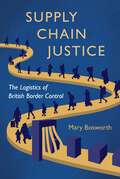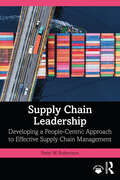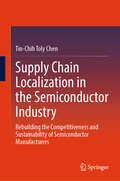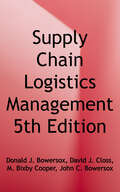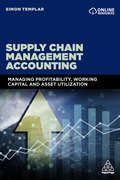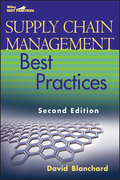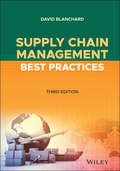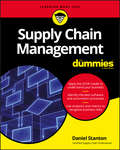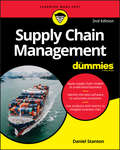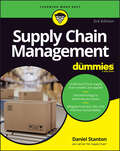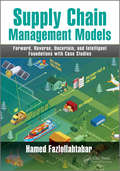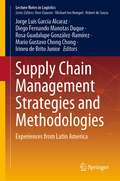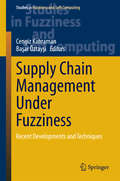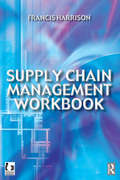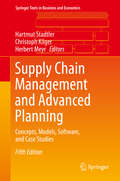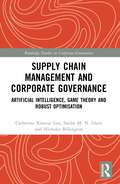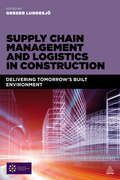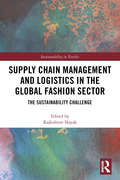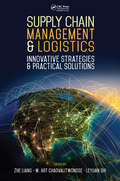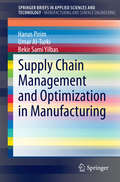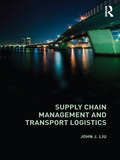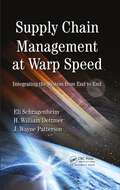- Table View
- List View
Supply Chain Justice: The Logistics of British Border Control
by Mary BosworthHow the UK&’s immigration detention and deportation system turns people into monetized, measurable units on a supply chain In the UK&’s fully outsourced &“immigration detainee escorting system,&” private sector security employees detain, circulate and deport foreign national citizens. Run and organized like a supply chain, this system dehumanises those who are detained and deported, treating them as if they were packages to be moved from place to place and relying on poorly paid, minimally trained staff to do so. In Supply Chain Justice, Mary Bosworth offers the first empirically grounded, scholarly analysis of the British detention and deportation system. Drawing on four years of extensive ethnographic research, Bosworth examines what keeps the system in place and whether it might be effectively challenged.Told by a senior manager that &“this is a logistics business,&” Bosworth documents how the public and private sectors have built a supply chain in which people&’s humanity is transformed both symbolically and tangibly through administrative processes and bureaucracy into monetized, measurable units. Like all logistics, the system has failure built into it. The contract does not seek to eradicate risk but rather to manage it, determining responsibility and apportioning a financial value to such &“failures&” as delay, escape, aborted flight or death in custody. Front-line workers and managers depoliticise and normalise their efforts by casting their duties in familiar bureaucratic terms, with targets, &“service level agreements&” and &“key performance indicators.&” Focusing on first-hand accounts from workers and lengthy observation and document analysis, Bosworth explores the impact of border logistics in order to ask what it would take to build inclusive infrastructures rather than those designed to exclude.
Supply Chain Leadership: Developing a People-Centric Approach to Effective Supply Chain Management
by Peter W. RobertsonSupply chain leaders are key to achieving sustainable supply chain excellence and long-term competitive advantage. This book addresses ‘big-picture’ supply chain leadership and provides a roadmap and practical advice to help supply chain leaders to successfully navigate this challenging social and technical environment. The book describes crucial leadership characteristics and explains the actions necessary to develop and appraise the skills in both new and existing leaders. It presents a socio-technical framework, which includes the key aspects of supply chain relationships, the supply chain business environment, overall supply chain competitiveness, supply chain sustainability, and supply chain risks. The book works through the recruitment, training, and development of leaders as well as obstacles and risks, to offer a fresh, people-centred approach. Pedagogy to aid learning is incorporated throughout, including an introduction to each chapter explaining the key learnings; tables, diagrams, and equations to help visualise the concepts and methods covered; real-life case studies and examples; and end of chapter review questions and assignment tasks. This textbook should be essential reading for advanced undergraduate and postgraduate students of supply chain, logistics, and operations management. The practice-based and applied approach also makes it valuable for operating supply chain leaders and those studying for professional qualifications. Online resources include chapter-by-chapter PowerPoint slides, a test bank of exam questions, and suggested tutorial topics.
Supply Chain Localization in the Semiconductor Industry: Rebuilding the Competitiveness and Sustainability of Semiconductor Manufacturers
by Tin-Chih Toly ChenThis book provides a comprehensive exploration of semiconductor supply chain localization, offering insights into the formulation of effective strategies and ways to enhance the competitiveness and sustainability of semiconductor manufacturers through supply chain localization. The semiconductor industry is currently witnessing a significant localization wave, with a growing trend of wafer foundries relocating their production capacity closer to chip designers. This shift is primarily driven by factors such as the US-China trade war, geopolitical considerations, the impact of Covid-19, the Russia-Ukraine conflict, and the increasing importance of environmental awareness. By localizing semiconductor supply chains, companies can effectively address these challenges while also improving their competitive edge and ensuring long-term sustainability in the face of political and war risks. However, achieving supply chain localization in the semiconductor industry is a complex endeavor, as traditional factors considered in semiconductor supply chain management may no longer be decisive. Moreover, existing research on the subject is often scattered across various journal issues and conference proceedings, necessitating a systematic integration of these findings. Furthermore, most of the available supply chain management-related books do not specifically focus on this topic. This book aims to bridge these gaps by providing a comprehensive resource that combines relevant references, real-world cases, and supporting evidence.
Supply Chain Logistics Management
by Donald J. Bowersox David J. Closs M. Bixby Cooper John C. BowersoxThis book presents Logistics in the context of integration within a firm's Supply Chain Strategy and Operations. The framework of Supply Chain Management is initially presented by creating a foundation for in-depth study of the five logistics operational components in Part Two. Challenges and strategies related to design and operational integration of logistics within a global supply chain are discussed in Part Three. Part Four focuses on administrative challenges related to cross organizational collaboration, performance measurement, and concludes with the challenges of managing risk and achieving sustainability. An essential feature of the overall presentation is the integration of topical materials and examples into the Supply Chain Logistics value creation process. Text materials are supported by study and challenge questions as well as contemporary cases. The presentation integrates the discussion of information technology throughout. Illustrations and examples highlight how firms deal with operational challenges and use logistics performance to gain competitive advantage.
Supply Chain Logistics: Foundational Knowledge
by Leo Reddy Rebekah HuttonGlobal Supply Chain Logistics, The Logistics Environment, Material Handling Equipment, Safety Principles, Safe Material Handling & Equipment Operation, Quality Control Principles, Work Communication, Teamwork & Good Workplace Conduct to Solve Problems, Using Computers.
Supply Chain Logistics: Mid-level Technical Knowledge
by Leo Reddy Rebekah HuttonSupply Chain Logistics: Mid-Level Technical Knowledge
Supply Chain Management Accounting: Managing Profitability, Working Capital and Asset Utilization
by Simon TemplarThe need to contain costs across the business is as strong as ever and the search for cost reduction opportunities is intensifying. There still remains one last major opportunity to take out costs - through the supply chain. Ultimately all costs will make their way to the final marketplace to be reflected in the price paid by the end user. Smart companies instead seek to make the supply chain more competitive through the value it creates and the costs it reduces overall. They have realised that the real competition is not company against company but rather supply chain against supply chain.Supply Chain Management Accounting looks at how the evolution of supply chains has been dramatic over the last few years, with more and more companies moving to sourcing overseas, distributing finished goods to overseas markets, and increasing their international operations. The seeking of low-cost country sourcing, optimizing manufacturing, and exporting products and services has created new challenges to demand forecasting and supply chain planning. Supply Chain Management Accounting presents a wide range of approaches and ground-breaking research findings. The book covers profitability, liquidity and asset utilisation, product costing, activity-based costing, investment appraisal, customer profitability analysis, budgeting and sales and operations planning. Online supporting resources include invaluable study questions and worked solutions to reinforce the learning as well as multiple-choice questions with solutions and PowerPoint activities.
Supply Chain Management Best Practices
by David BlanchardLearn what it takes to develop and have a "best-in-class" supply chain This new edition shows you how to build supply chains that work by illustrating how leading companies are doing it. Identifying world-class supply chains in more than a dozen different industries and explaining in detail how these companies got to where they are, this essential book reveals the proven strategies, solutions, and performance metrics used by leading companies to design their extended enterprises. Identifies proven strategies, solutions, and performance metrics for supply chain management best practice benchmarks Shows how to manage supply chains in a global marketplace and how to choose third-party providers New edition includes new chapters on green supply chains and lean supply chains, and expanded analysis of emerging technologies Includes coverage of supply chain metrics, planning and forecasting, procurement, manufacturing, transportation, globalization, customer service, collaboration, security, and workforce management Written by the Editorial Director of Penton Media's Supply Chain Group and a Contributing Editor to IndustryWeek magazine It also offers guidance on the latest technology, green supply chains, going lean, how to choose third-party logistics providers, and how to manage the supply chain in a global environment.
Supply Chain Management Best Practices
by David BlanchardLearn from leaders across industries to develop a tech-enabled "best-in-class" supply chain Supply Chain Management Best Practices, Third Edition, is the long-awaited update to a classic resource. Since the second edition was published, the demands of the marketplace have radically shifted the dynamics of supply chain management. Transportation and fulfillment must now accommodate the technological gains that have transferred computing power from mainframes and workstations into smartphones in hands around the world. This updated book covers the new concepts, processes, and technologies that today’s supply chain professionals must know—including drones, the Internet of Things, same-day delivery, artificial intelligence, and more. Award-winning author David Blanchard discusses how companies are actively using these technologies and gaining competitive advantage through their implementation. Like its predecessors, this edition focuses on industry trends and case studies, offering the stories, recent examples of supply chain initiatives, and insights into new best practices. You'll learn proven methods for measuring the performance of a supply chain, including traditional core processes and new, extended strategies being used by today’s leading companies. Identifies proven strategies, solutions, and performance metrics for supply chain management best practices Shows how to manage supply chains in a global marketplace and how to choose third-party providers Includes new coverage of today’s game-changing supply chain technologies: drones, the Internet of Things, same-day delivery, omni-channel distribution, artificial intelligence, Uber-style freight transportation apps, blockchain, robotics, and more Discusses supply chain metrics, planning and forecasting, procurement, manufacturing, transportation, distribution, globalization, customer service, risk management, supply chain finance, and workforce management This invaluable guide for supply chain professionals, CFOs, CIOs, and others, also offers guidance on green supply chains and managing logistics in a global environment.
Supply Chain Management For Dummies
by Daniel StantonEveryone can impact the supply chain Supply Chain Management For Dummies helps you connect the dots between things like purchasing, logistics, and operations to see how the big picture is affected by seemingly isolated inefficiencies. Your business is a system, made of many moving parts that must synchronize to most efficiently meet the needs of your customers—and your shareholders. Interruptions in one area ripple throughout the entire operation, disrupting the careful coordination that makes businesses successful; that's where supply chain management (SCM) comes in. SCM means different things to different people, and many different models exist to meet the needs of different industries. This book focuses on the broadly-applicable Supply Chain Operations Reference (SCOR) Model: Plan, Source, Make, Deliver, Return, and Enable, to describe the basic techniques and key concepts that keep businesses running smoothly. Whether you're in sales, HR, or product development, the decisions you make every day can impact the supply chain. This book shows you how to factor broader impact into your decision making process based on your place in the system. Improve processes by determining your metrics Choose the right software and implement appropriate automation Evaluate and mitigate risks at all steps in the supply chain Help your business function as a system to more effectively meet customer needs We tend to think of the supply chain as suppliers, logistics, and warehousing—but it's so much more than that. Every single person in your organization, from the mailroom to the C-suite, can work to enhance or hinder the flow. Supply Chain Management For Dummies shows you what you need to know to make sure your impact leads to positive outcomes.
Supply Chain Management For Dummies
by Daniel StantonIncrease your knowledge of supply chain management and leverage it properly for your business If you own or make decisions for a business, you need to master the critical concept of supply chain management. Supply Chain Management For Dummies, 2nd Edition guides you to an understanding of what a supply chain is and how to leverage this system effectively across your business, no matter its size or industry. The book helps you learn about the areas of business that make up a supply chain, from procurement to operations to distribution. And it explains the importance of supporting functions like sales, information technology, and human resources. You’ll be prepared to align the parts of this system to meet the needs of customers, suppliers, and shareholders. By viewing the company as a supply chain, you’ll be able to make decisions based on how they will affect every part of the chain. To help you fully understand supply chains, the author focuses on the Supply Chain Operations Reference (SCOR) model. This approach allows all types of professionals to handle their work demands. • Use metrics to improve processes • Evaluate business risks through analytics • Choose the right software and automation processes • Plan for your supply chain management certification and continuing education A single business decision in one department can have unplanned effects in one or more areas, such as purchasing or operations. Supply Chain Management For Dummies helps you grasp the connections between business lines for wiser decision making and planning.
Supply Chain Management For Dummies
by Daniel StantonPutting together all the links in the supply chain Supply Chain Management For Dummies gives you the full rundown on what a supply chain is, how it works, how to optimize it, and the best education for a rewarding supply chain career. This new edition is fully updated for changes to the supply chain in a post-Covid world. You’ll learn about the latest supply chain technologies, analytics and data-based optimization, and new strategies for delivering on your organization’s promises. This approachable resource can take your supply chain management skills to the next level with step-by-step explanations, expert tips, and real-life examples. Gain a foundational knowledge of issues in supply chain management Learn about today’s global supply chains, plus trends like reshoring and near-shoring Wrap your mind around how an organization’s moving parts can be coordinated in today’s high-tech world Discover strategies for dealing with disruptions, focusing on diversity, and increasing resilience This For Dummies guide is great for entry-level supply chain professionals and anyone who needs an update on need-to-know concepts and recent changes in supply chain management.
Supply Chain Management Models: Forward, Reverse, Uncertain, and Intelligent Foundations with Case Studies
by Hamed FazlollahtabarSupply Chain Management (SCM) is a wide field in which several specialties are included. In general, operations and production management players use SCM to organize the problems and analyze the solution approaches. Due to these points, a reference which can encompass a range of problems and their modelling approaches is required. This book will contain three general sections of forward, reverse, intelligent, and uncertain problems. While the book provides different problems in the three commonly used categories in SCM, it is very helpful for the readers to find out, or adapt their own application studies to the ones given in the book and employ the corresponding modeliing approach.
Supply Chain Management Strategies and Methodologies: Experiences from Latin America (Lecture Notes in Logistics)
by Jorge Luis García Alcaraz Rosa Guadalupe González-Ramírez Mario Gustavo Chong Chong Irineu de Brito Junior Diego Fernando Manotas DuqueThis book showcases the successful practices of manufacturing companies in Latin America, highlighting the strategies and technologies they have implemented to produce high-quality products and remain competitive in the market. Divided into three parts, the book covers various aspects of the manufacturing process. Part I presents methodologies and strategies for demand forecasting and raw material procurement, providing insights into how companies are meeting their production needs and managing costs. Part II focuses on methodologies and strategies applied in the production process, exploring the various techniques and practices that companies are utilizing to optimize their manufacturing operations. Finally, Part III lists methodologies and strategies applied to product distribution, demonstrating how companies are delivering their products to market efficiently and effectively. Overall, this book provides a comprehensive overview of the best practices being employed by successful manufacturing companies in Latin America, offering valuable insights for businesses looking to improve their manufacturing processes and remain competitive in today's market.
Supply Chain Management Under Fuzziness
by Cengiz Kahraman Başar ÖztayşiSupply Chain Management Under Fuzziness presents recently developed fuzzy models and techniques for supply chain management. These include: fuzzy PROMETHEE, fuzzy AHP, fuzzy ANP, fuzzy VIKOR, fuzzy DEMATEL, fuzzy clustering, fuzzy linear programming, and fuzzy inference systems. The book covers both practical applications and new developments concerning these methods. This book offers an excellent resource for researchers and practitioners in supply chain management and logistics, and will provide them with new suggestions and directions for future research. Moreover, it will support graduate students in their university courses, such as specialized courses on supply chains and logistics, as well as related courses in the fields of industrial engineering, engineering management and business administration.
Supply Chain Management Workbook
by Francis Harrison'Supply Chain Management Workbook' provides an overview of the supply chain process and addresses the key aspects involved in a supply chain. A checklist is included to enable an assessment of a company's procedures and the facilities it offers. By working through this list of questions the weaknesses in the management of the supply chain can be identified and subsequently addressed.The combination of theoretical underpinning along with a means of self evaluation results in a practical guide which will be invaluable for companies wishing to improve their supply chain management.Published in Association with The Institute of Operations Management, http://www.iomnet.org.uk.
Supply Chain Management and Advanced Planning
by Hartmut Stadtler Christoph Kilger Herbert MeyrSupply Chain Management, Enterprise Resources Planning (ERP), and Advanced Planning Systems (APS) are important concepts in order to organize and optimize the flow of materials, information and financial funds. This book, already in its fifth edition, gives a broad and up-to-date overview of the concepts underlying APS. Special emphasis is given to modeling supply chains and implementing APS successfully in industry. Understanding is enhanced by several case studies covering APS from various software vendors. The fifth edition contains updated material, rewritten chapters and an additional case study.
Supply Chain Management and Corporate Governance: Artificial Intelligence, Game Theory and Robust Optimisation (Routledge Studies in Corporate Governance)
by Sardar M. Islam Catherine Xiaocui Lou Nicholas BillingtonSupply Chain Management and Corporate Governance: Artificial Intelligence, Game Theory and Robust Optimisation is the first innovative, comprehensive analysis and analytical robust optimisation modelling of the relationships between corporate governance principles and supply chain management for risk management and decision-making under uncertainty in supply chain operations. To avoid corporate failures and crises caused by agency problems and other external factors, effective corporate governance mechanisms are essential for efficient supply chain management. This book develops a new collaborative robust supply chain management and corporate governance (RSCMCG) model and framework that combines good corporate governance practices for risk management strategies and decision-making under uncertainty. This model is developed as a principal–agent game theory model, and it is digitalised and computed by Excel algorithms and spreadsheets as an artificial intelligence and machine-learning algorithm. The implementation of the RSCMCG model provides optimal supply chain solutions, corporate governance principles and risk management strategies for supporting the company to achieve long-term benefits in firm value and maximising shareholders’ interests and corporate performance while maintaining robustness in an uncertain environment. This book shows the latest state of knowledge on the topic and will be of interest to researchers, academics, practitioners, policymakers and advanced students in the areas of corporate governance, supply chain management, finance, strategy and risk management.
Supply Chain Management and Logistics in Construction
by Greger LundesjoThe construction logistics manager plays an increasingly central role in the construction process. In fact, their decisions can crucially affect the success or failure of a project. Recognition of the critical role they play has spurred evermore interest in this budding field amongst both researchers and practitioners. An accessible text on construction logistics, Supply Chain Management and Logistics in Construction provides essential guidance and expert advice for construction managers, as well as researchers and students in the field. This important new title looks at arrangements with suppliers, the use of returnable packaging and off-site manufacture and assembly, IT systems used to manage the supply chain and logistics operations, such as delivery management systems, warehouse management systems and material planning and forecasting systems. It also considers aspects of the contractual relationships between client, developer, main contractor and lower-tier contractors, all of which have an impact on how the supply chain is managed. In addition to providing a range of fresh ground-breaking case studies, the book features contributions from leading experts in the field who have been involved in projects with companies such as TFL, BAA, The Red Cross, as well as big construction programmes such as the Olympics and Cross Rail.
Supply Chain Management and Logistics in Construction: Delivering Tomorrow's Built Environment
by Greger LundesjöThe construction logistics manager plays an increasingly central role in the construction process. In fact, their decisions can crucially affect the success or failure of a project. Recognition of the critical role they play has spurred evermore interest in this budding field amongst both researchers and practitioners. An accessible text on construction logistics, Supply Chain Management and Logistics in Construction provides essential guidance and expert advice for construction managers, as well as researchers and students in the field. This important new title looks at arrangements with suppliers, the use of returnable packaging and off-site manufacture and assembly, IT systems used to manage the supply chain and logistics operations, such as delivery management systems, warehouse management systems and material planning and forecasting systems. It also considers aspects of the contractual relationships between client, developer, main contractor and lower-tier contractors, all of which have an impact on how the supply chain is managed.In addition to providing a range of fresh ground-breaking case studies, the book features contributions from leading experts in the field who have been involved in projects with companies such as TFL, BAA, The Red Cross, as well as big construction programmes such as the Olympics and Cross Rail.
Supply Chain Management and Logistics in the Global Fashion Sector: The Sustainability Challenge (Textile Institute Series: Responsibility and Sustainability)
by Rajkishore NayakThe ways in which we design, make, transport and then discard clothes has a huge social and environmental impact. This book covers responsible business practices and sustainability in the fashion industry from the raw fibre stage, through production, to the point of customer consumption. The concepts of responsibility and sustainability are fast becoming essential factors in business decisions and Responsible Supply Chain Management leads the reader through the multiple stages in the supply chain that can impact on business strategy. A perfect resource for students studying fashion and for those working in the sector who wish to identify the latest thinking as they plan sustainability strategies, the book is divided into four clear sections. The first introductory part of the book examines sustainability in the supply chain by identifying the main three pillars of sustainability (social, economic and environmental) and considers which fashion brands are innovating in this area. Part two looks at fashion logistics and supply chain operations by assessing fibre, yarn and fabric considerations, logistical issues for both garment production, and service delivery, stock control, transportation, barriers and risks. The third part develops the logistics theme further by identifying recent trends and case studies that highlight agility and lean management structures, and the application of transparency enhancing RFID. This section further applies modelling and simulation techniques from the automotive and pharmaceutical industries to the fashion sector. The final part considers how sustainability can be embedded into the multi-tiered fashion supply chain and its selling environment.
Supply Chain Management and Logistics: Innovative Strategies and Practical Solutions (Industrial and Systems Engineering Series)
by Zhe Liang Wanpracha Art Chaovalitwongse Leyuan ShiDesigned by practitioners for practitioners, Supply Chain Management and Logistics: Innovative Strategies and Practical Solutions provides a wide-spectrum resource on many different aspects involved in supply chain management, including contemporary applications. With contributions from leading experts from all over the world, the book includes innovative strategies and practical solutions that address problems encountered by enterprise in management of supply chain and logistics. It details general techniques and specific approaches to a broad range of important, inspiring, and unanswered questions in the field.The book is organized around four major research themes in supply chain management: 1) supply chain strategy and coordination, 2) supply chain network optimization, 3) inventory management in supply chain, and 4) financial decisions in supply chain. The sequence of these themes helps transition from an enterprise-wide framework to network design to operational management to financial aspects of the supply chain. Each individual theme also addresses the answer to a challenging question as to how to go about applying quantitative tools to real-life operations, resulting in practical solutions.As the world moves toward more competitive and open markets, effective supply chain management is of critical importance to the success or failure of an enterprise. Despite a large amount of research achieved in the past decades on the supply chain management topic, many researchers and practitioners are still devoting considerable efforts on the emerging new problems. Designed to give you a collection of topics that bridge the gap between the academic arena and industrial practice, the book supplies a contemporary and up-to-date review on the advanced theory, applications, and practices of supply chain management, making it a rich resource for the design, analysis, and implementation of supply chain management problems arising in a wide range of industries.
Supply Chain Management and Optimization in Manufacturing
by Harun Pirim Umar Al-Turki Bekir Sami YilbasThis book introduces general supply chain terminology particularly for novice readers, state of the art supply chain management and optimization issues and problems in manufacturing. The book provides insights for making supply chain decisions, planning and scheduling through supply chain network. It introduces optimization problems, i. e. transportation of raw materials, products and location, inventory of plants, warehouses and retailers, faced throughout the supply chain network.
Supply Chain Management and Transport Logistics
by John J LiuThe enterprise-focused framework of supply chain, which an overwhelming majority of books on supply chain management (SCM) have adopted, falls short in explaining recent developments in the real world, especially the so-called Wal-Mart model, in which a 'factory' is a virtual logistics network of multiple international manufacturing firms. The book fills the gap and examines supply chain and transport logistics. The book also includes the development of a unified methodological framework which underpins all the characteristics of the interrelationship between supply chain management and logistics. It covers many aspects of the important and innovative developments well. The book offers a unique coverage of integrated logistics of navigation, aviation and transportation. The book not only answers the urgent need for a book on supply chain management and transport logistics but also highlights the central role of supply chain logistics in the emerging fields of sustainable (green), humanitarian and maritime supply chains and the importantance of studying supply chain management together with transport logistics. It also explains the difference between supply chain logistics and manufacturing logistics. It is a useful reference for those in the industry as well as for those taking related courses.
Supply Chain Management at Warp Speed: Integrating the System from End to End
by Eli Schragenheim H William Dettmer J. Wayne PattersonThis sequel to the bestselling Manufacturing at Warp Speed, refines and updates the former approach to production management. This is the first book to describe, in detail, the application of the TOC approach to assured availability in distribution, for both original equipment manufacturers and retailers. It addresses the new demands taken on when a firm offers to handle rush orders and addresses the issues surrounding availability, and the management of inventory as it moves through distribution systems.
